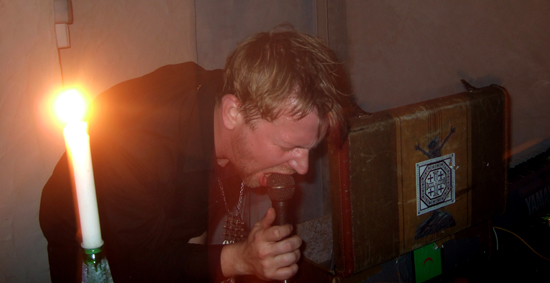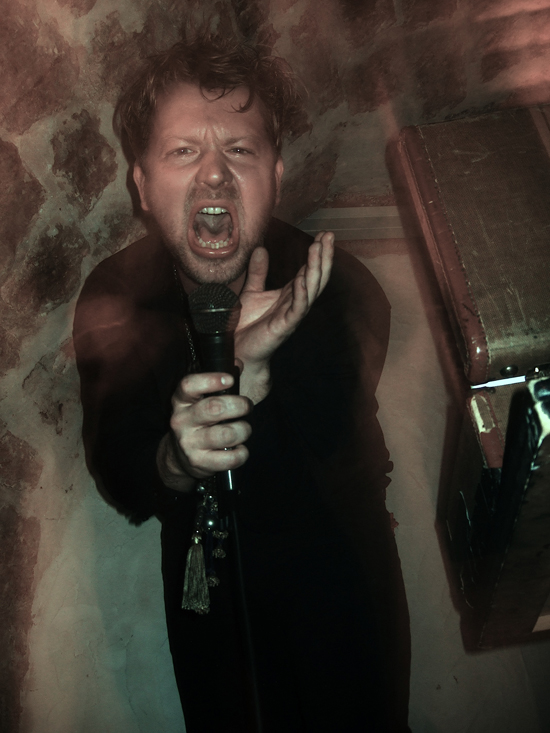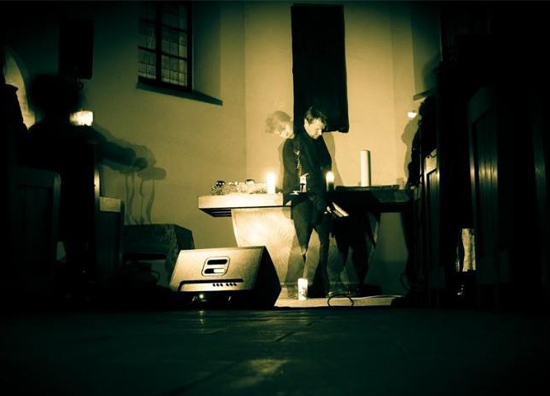To listen to any of Burial Hex’s many releases, which have manifested across almost all known formats over the past nine years, is to commune with dark, deathly atmospheres that contrast elegant instrumentation and rhythms with entropic noise. Drawing on a wealth of influences, from 19th Century European chamber music to industrial, from the stories of HP Lovecraft to the Italian horror movies of the 70s, its sound provokes questing minds to ponder on the supernatural, the liminal space between life and death, or the many and varied traditions and rituals that preserve occult philosophies down the ages.
But all this is about to end as Clay Ruby, the multi-instrumentalist behind these chthonic and ethereal sounds, has stated that Burial Hex is to be laid to rest, permanently and imminently, as part of a preordained strategy that has informed all of its output from the very beginning.
At such a delicate and portentous time, Clay Ruby discusses aspects of his work as Burial Hex as he prepares for the final stage in its cycle, while shining a light on his prolific collaborative work that reaches far outside his solo project and reveals a vast network of underground artists spread throughout America’s Midwest and beyond…
From its outset in 2004, Burial Hex has been consistently defined as ‘horror electronics’, made from combining aspects of industrial music with power electronics. With more recent releases such as In Psychic Defense and Book of Delusions featuring arguably more accessible elements including song and more regular rhythms, have you deliberately broadened the project in terms of style more recently?
Clay Ruby: It is not a recent broadening for Burial Hex. One of the main themes of this composition cycle is to limit myself to what comes most naturally. I live mere hours from Chicago and Milwaukee, my whole life I have been infatuated with and surrounded by all manner of electronic rhythm. As the years wore on, these song and rhythm elements from disco, house, electro and industrial musics have organically manifested.
I also feel that horror electronics is not only made from combining aspects of industrial with power electronics, but also including the influence of horror movie soundtracks. This additional aspect allows me a much more progressive attitude about what seems right within the structure of the Burial Hex cycle.
‘Horror electronics’ serves the music well as a descriptor, alluding to the dark ambience of such films’ soundtracks. Have any particular films or soundtrack composers directly influenced the Burial Hex sound?
CR: Sure, I love Goblin, Wendy Carlos, Ennio Morricone, Fabio Frizzi, Tobe Hooper and Wayne Bell, Alejandro Jodorowsky, David Lynch, etc.
How do you tend to go about recording a Burial Hex album? Is it predominantly generated live in the studio or slowly sculpted over long periods of time?
CR: Recordings are slowly sculpted over time, but I often use live recording as one of many strategies in the studio.
Burial Hex – Book of Delusions from Clay Ruby on Vimeo.
You’ve spoken before about Burial Hex having an underlying concept examining spiritual attitudes to death and the beyond. Does this originate from any firm beliefs – esoteric, religious or otherwise – or is it from a more scholarly standpoint; or is it, perhaps, like most horror films, more for its seductively dramatic effects?
CR: I am often disappointed at how little actual occult research seems to go into most horror or occult inspired artforms, because the real thing can be much more seductively dramatic when effectively put to use within art. I do have some ideas about life after death and the beyond. I continue living a private practice of esoteric art that draws inspiration from many sources, some of which I have attempted to make evident within my public works.
You’ve been clear about Burial Hex’s imminent end, describing its first self-titled LP and the subsequent Initiations LP as two instalments in a preconceived trilogy or cycle that will conclude with the forthcoming LP, Final Mysteries (with all other releases as preliminary studies informing these more definitive releases). How near are you to completing this last release, and what are your musical plans once Burial Hex is laid to rest?
CR: Burial Hex is a composition cycle which will come to an end. Recordings have been in the works for Final Mysteries since 2010, with plans to finish in 2012. After which I hope to relax and take a breath, and then continue exploring music in many other ways.
Even though I am always flush with work, Burial Hex has truly grown to take up much more of my time than initially expected. As you will undoubtedly ask me about, there are many sides to my musical life outside of Burial Hex, and this will probably continue to expand and develop after I have finished writing and recording for this cycle.

You released Burial Hex’s last album, Book of Delusions, on your own label Brave Mysteries in the end, after several record labels failed to make good on their offers to release it. What issues prevented it from being released earlier and did the gestation period this imposed change the music in any way?
CR: I was initially asked to do Book of Delusions by Troubleman Records in 2008. Between 2008 and 2011, it was in the hands of a couple of different labels. You’ll forgive me if I don’t want to go into all the details. Anyone trying to get a record out in the underground knows that many problems can arise. It is interesting how the music did indeed change over the three years. The architecture of Book of Delusions was conceived of right away, to make the first side a set of sacral industrial pieces and make the B-side one long dancefloor epic. I began work on the B-side and then, over the three years, it was just one long mix session of continually tightening, heightening, adding and subtracting. The A-side actually changed radically, several times over the years. Entire songs have been written and erased, aspects from many different sessions are combined and manipulated. The end result is a collage of three years’ worth of meditating on this project.
Before launching your ‘Burial Hex’ cycle you released harsh noise experiments as Metrocide, amongst other names. What lead to you exploring more musical, less automated and abrasive sounds? What do you think of the current Harsh Noise Wall scene?
CR: Metrocide and many of my earlier experiments were coming from a specific interest in unconventional instruments and methods that were new to me at the time. My musical life was formed by piano lessons and teenage garage bands recording on four-track tape recorders. Exploring with effects, synthesis, circuit bending and electronic music was a natural progression. This kind of "automated and abrasive" sound provided a whole new sonic dimension to work within, and my projects from the early days of 23 Productions are a reflection of these experiments.
I eventually became interested in music that was composed with specific intention and explored certain themes. The music of Burial Hex was intended to include anything from my own life, which meant everything I had experimented with, including total electronic noise. I have always imagined the more musical moments of Burial Hex to be emerging from and returning unto a greater chaos of voidist noise.
My interest in the current Harsh Noise Wall scene is partially handicapped by the fact that I am still absorbed in my first such loves, which include Incapacitants, Macronympha, Dead Body Love, Richard Ramirez, etc. Of course, I am always curious about the newest recordings from Vomir and The Rita. Sometimes I do get booked to play with a younger HNW artist and it is always a pleasure to see yet another take on this sound, especially enduring the test of a live performance.
Outside of Burial Hex, you regularly feature on an even more bewildering array of releases – mostly in collaboration with other Madison-based artists, many of which are involved with The Davenport Family, a free folk collective you formed in 2002, and more recently its successor, Second Family Band. What is it about Madison that cultivates such a fertile music scene? To what degree, if any, have your experiences as part of these collectives fed into your more solitary work as Burial Hex?
CR: These experiences certainly feed into my solo work. Many times, after a heavy session with the Second Family Band, some musical idea comes from my unique experiences working within this scene. Then, when working within the more personal context of Burial Hex, these themes and modes naturally reappear.
These days you seem to be working particularly closely and regularly with Nathaniel Ritter of Kinit Her. As well as setting up the Brave Mysteries label together in 2010, you tend to appear often on each other’s releases. How did you meet? Or are you one and the same person, as has been suggested by some websites?
CR: No, we are actually quite different people in many ways. In fact we’ve noticed that our many polarities contribute to keeping the label work interesting and effective. According to Nate, he didn’t even know that Burial Hex was from Wisconsin, and once he figured out that we lived in the same city, he contacted me about playing a show with Kinit Her. There was a period of time in Madison when Kinit Her, Burial Hex, Zola Jesus, Peaking Lights and Second Family Band were all playing local shows together regularly.

So what do you think it is it about Wisconsin that has nurtured such an abundance of experimental and underground musics?
CR: Wisconsin is dark, cold, unsophisticated, isolated and alienating. It has always been a great place to hide yourself away and work on art, so long as you are willing to work alone, without any support or distractions from the local scene.
Your collaborations have also lead further afield, particularly with James Toth (JJT) in Wooden Wand and the Vanishing Voice (WWVV) and more recently members of Italian New Wave act Teenage Panzercorps (as Horrid Red) and the so-called ‘witch house’ of Mater Suspiria Vision. What first attracted you to work with these guys and to what extent do these experiences in vastly differing styles feed into your work as Burial Hex?
CR: I hosted a festival in 2004 called Pasture Music Festival and Jubilee. I booked Wooden Wand and the Vanishing Voice to play at a beautiful afternoon stage inside a 150 year old barn that was literally packed with people, many of whom had never heard of JJT or WWVV before. This festival was the first time that many people, including myself, Jack Rose, Glenn Donaldson, Loren Chase, James Ferraro, Spencer Clark, James Jackson Toth, Christina Carter, MV & EE, and many others met and saw each other perform for the first time. Over the next couple years I toured with WWVV twice and with various Wooden Wand incarnations. We also created the bands Jex Thoth and The Zodiacs together.
From this festival, my relationship with Glenn Donaldson also flourished. Over the years we have messed around with a lot of projects together. He was also involved with Jex Thoth and wrote many of their greatest songs. I was nearly the keyboardist for Teenage Panzerkorps once, but had to leave their Berlin recording session one day too early. Once Donaldson aka Edmund Xavier and Bunker Wolf began expanding their punk ideas beyond TPK and started Horrid Red, it seemed natural that I collaborate with this project. At first I was just doing odd sound design favors for them, but eventually I was playing keys, making beats and contributing to the songwriting. Now Horrid Red is the full time duo of Xavier and I, supporting the epic Bunker Wolf at center stage.
Cosmotropia de Xam was looking for some folks slightly more outside of the confines of the witch house universe to remix some of his Mater Suspiria Vision tracks. We bonded over a common love of rare kraut and psych music, and it was very fun exchanging remixes. Since then we stay in frequent correspondence, we played a wonderful Robot Elephant event in London together, Brave Mysteries has released the second Pwin Teaks album on vinyl [a Mater Suspiria Vision side-project] and we are talking to Cosmotropia de Xam about some future releases as well.
In all of these cases, what attracts and bonds me to my collaborators seems their unique visionary music matched with their totally fearless approach to life and culture. All of us are able to work within a multitude of styles and medium from beyond the confines of the scenes we might be normally associated with.
You’re also in a black metal band, Wormsblood, which seems to help join the stylistic dots between your explorations in folk and noise. How important is black metal to you and your work and what do you think of the scene these days?
CR: Metal has always been important to me, it was one of my first loves. As with many other scenes, I am quite slow to keep up with what’s happening these days. Aside from loving the black metal classics (early Mayhem, Sarcofago, Von, Hellhammer, Darkthrone, Graveland) I still think that Urfaust, Nuit Noire, and Circle of Ouroborus are doing interesting things. I have a planned collaboration in the works with Urfaust too!
I was in attendance at the 2010 Nuclear War Now! Festival in Berlin, and it was quite overwhelming. As much as I enjoy many of the bands that played (everyone from Bone Awl to Blasphemy), it was a bit mind numbing, and after three days – yes, we even attended the Vulcano pre-show – of total aesthetic oblivion, I was practically becoming nauseated by anything wearing a leather jacket.


